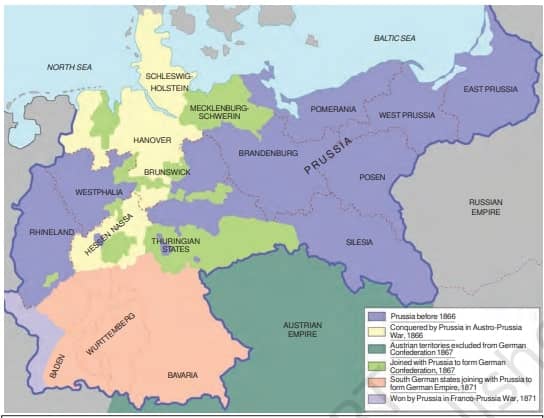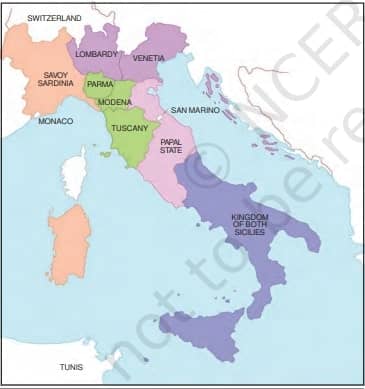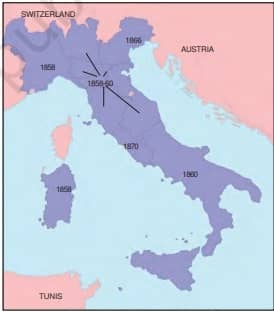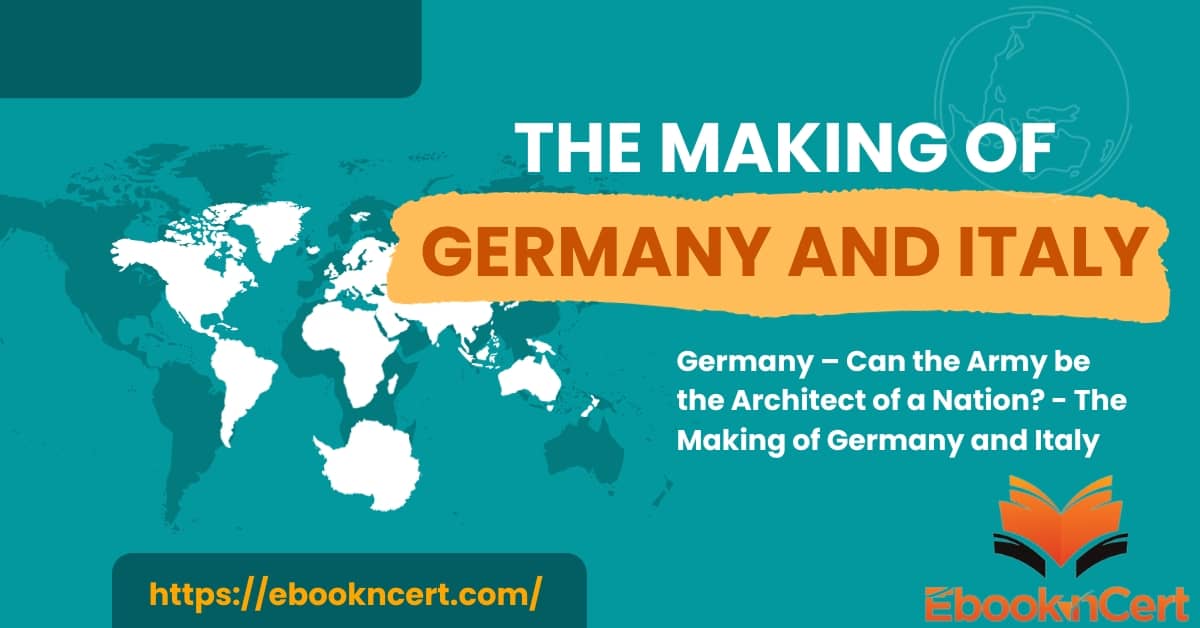The Making of Germany and Italy – Concept & Free PDF Notes
Topic & sub-topics covered: The Making of Germany and Italy, Germany – Can the Army be the Architect of a Nation?, Italy Unified: The Rise of Nationalism in Europe (All single detail notes that are exam-oriented)
We have discussed in-depth and exam-oriented pointers that can be asked in the board exam of class 10th about “The Making of Germany and Italy: Germany – Can the Army be the Architect of a Nation?” which is taken from the NCERT History book for class 10th and chapter no. 1st “The Rise of Nationalism in Europe”.
Download the PDF of NCERT for Class 10th Social Science History Notes Chapter 1 – The Rise of Nationalism in Europe
We have attached the class 10 history chapter 1 notes pdf “the rise of nationalism in Europe notes pdf” in this blog you can download it from our website for quick revision for your examination.
Germany – Can the Army be the Architect of a Nation? – The Making of Germany and Italy
1. Shift in Nationalism Post-1848:
- After 1848, nationalism in Europe moved away from its association with democracy and revolution.
- Nationalist sentiments were utilized by conservatives to promote state power and gain political dominance in Europe.
2. Unification of Germany and Italy:
- Nationalist feelings were widespread among middle-class Germans in 1848, aiming to unite the German confederation into a nation-state with an elected parliament.
- The liberal initiative for nation-building was suppressed by the monarchy, military, and Prussian landowners (Junkers).
- Prussia assumed leadership under Otto von Bismarck, who orchestrated the unification process through wars with Austria, Denmark, and France.
- Prussian victory in 1871 led to the proclamation of William I as German Emperor in Versailles.
3. Bismarck’s Role in German Unification:
- Otto von Bismarck, as chief minister of Prussia, played a crucial role in the German unification process.
- Utilized the Prussian army and bureaucracy in three wars over seven years with Austria, Denmark, and France to achieve unification.
4. Proclamation of German Empire (1871):
- On January 18, 1871, a gathering at the Hall of Mirrors in the Palace of Versailles proclaimed the new German Empire.
- The assembly comprised princes of German states, army representatives, and key Prussian ministers, including Otto von Bismarck.
5. Dominance of Prussian State Power:
- The nation-building process in Germany highlighted the dominance of Prussian state power.
- The new German state emphasized modernization in currency, banking, legal, and judicial systems.
- Prussian measures and practices often served as a model for the rest of Germany.
Summary of Important Point for Exam from “The Making of Germany and Italy“
- Recognize the shift in nationalism post-1848, as it became associated with conservative goals and state power.
- Understand the failed liberal initiative for German nation-building in 1848 and the subsequent dominance of Prussia in leading the unification process.
- Analyze Otto von Bismarck’s role in orchestrating the unification of Germany through wars and political maneuvering.
- Comprehend the significance of the proclamation of the German Empire in 1871 at Versailles.
- Highlight the impact of Prussian state power on the new German state, influencing modernization in various sectors and serving as a model for the rest of the country.
Italy Unified
1. Historical Background of Italian Political Fragmentation:
- Italy, similar to Germany, experienced prolonged political fragmentation during the 19th century.
- Italians were dispersed across various dynastic states and the multi-national Habsburg Empire.
2. Division of Italy into Seven States:
- Italy, in the mid-19th century, was divided into seven states.
- Only Sardinia-Piedmont was ruled by an Italian princely house.
3. Austrian, Papal, and Bourbon Dominance:
- The northern region was under Austrian Habsburgs, the central region was ruled by the Pope, and the southern regions were under the Bourbon kings of Spain.
- The Italian language had diverse regional and local variations.
4. Giuseppe Mazzini’s Efforts for a Unitary Italian Republic:
- During the 1830s, Giuseppe Mazzini aimed to create a coherent program for a unitary Italian Republic.
- He formed the secret society ‘Young Italy’ to disseminate his goals.
5. Shift to Sardinia-Piedmont for Unification:
- Failures of revolutionary uprisings in 1831 and 1848 led to the mantle falling on Sardinia-Piedmont, led by King Victor Emmanuel II, for Italian unification through war.
6. Role of Chief Minister Cavour:
- Chief Minister Cavour, not a revolutionary or democrat, played a pivotal role in unifying Italian regions.
- He spoke French better than Italian, showcasing the elite’s linguistic preferences.
7. Diplomatic Alliance and Defeat of Austrian Forces:
- Cavour engineered a diplomatic alliance with France, leading to the defeat of Austrian forces in 1859.
- Armed volunteers, under Giuseppe Garibaldi, joined in, marching into South Italy and the Kingdom of the Two Sicilies.
8. Unification and Victor Emmanuel II’s Proclamation:
- In 1860, armed volunteers won support from local peasants to drive out Spanish rulers.
- In 1861, Victor Emmanuel II was proclaimed king of united Italy.
9. Lack of Awareness Among Italian Population:
- Despite unification, a significant portion of the Italian population, with high illiteracy rates, remained unaware of liberal-nationalist ideology.
- Peasants supporting Garibaldi in southern Italy associated ‘La Talia’ with Victor Emmanuel’s wife, not recognizing the concept of Italia.
Summary of Important Topic for Exam from this Topic “Italy Unified“
- Recognize Italy’s historical background of political fragmentation and division into seven states.
- Understand Giuseppe Mazzini’s efforts for a unitary Italian Republic and the shift to Sardinia-Piedmont for unification.
- Analyze Chief Minister Cavour’s role, linguistic preferences, and the defeat of Austrian forces in the unification process.
- Comprehend the lack of awareness among the Italian population regarding liberal-nationalist ideology, especially among the peasant masses.
Unification of Germany (1866-71)
Italian states before unification, 1858

Italy after unification

The Strange Case of Britain
1. Great Britain as a Model for Nation-State Formation:
- Some scholars argue that Great Britain serves as a model for the nation-state.
- The formation of the British nation-state was not abrupt but a gradual, long-drawn-out process.
2. Absence of a British Nation Before the Eighteenth Century:
- Before the eighteenth century, there was no distinct British nation.
- Primary identities were ethnic – English, Welsh, Scot, or Irish, each with its cultural and political traditions.
3. Growth of English Influence and Power:
- The English nation’s growth in wealth, importance, and power enabled it to extend its influence over other nations in the British Isles.
- English parliament played a crucial role, in seizing power from the monarchy in 1688.
4. Act of Union (1707) and Dominance of England:
- The Act of Union in 1707 between England and Scotland led to the formation of the ‘United Kingdom of Great Britain.’
- England imposed its influence on Scotland, dominating the British parliament with English members.
5. Suppression of Scotland’s Distinctive Culture:
- The growth of a British identity resulted in the systematic suppression of Scotland’s distinctive culture and political institutions.
- Scottish Highlanders faced repression, including restrictions on language, dress, and forced displacement.
6. Similar Fate for Ireland:
- Ireland, deeply divided between Catholics and Protestants, suffered a fate similar to Scotland.
- English assistance to Irish Protestants led to their dominance over the largely Catholic country.
7. Suppression of Catholic Revolts and Forced Incorporation (1801):
- Catholic revolts against British dominance in Ireland were suppressed.
- After a failed revolt in 1798 led by Wolfe Tone and the United Irishmen, Ireland was forcibly incorporated into the United Kingdom in 1801.
8. Formation of a New ‘British Nation’:
- A new ‘British nation’ was forged through the promotion of dominant English culture.
- Symbols like the British flag (Union Jack), the national anthem (God Save Our Noble King), and the English language were actively promoted.
Summary of Important Topic for Exam from this Topic “The Strange Case of Britain“
- Understand Great Britain as a model for gradual nation-state formation.
- Recognize the absence of a British nation before the eighteenth century and the role of ethnic identities.
- Analyze the growth of English influence, the Act of Union (1707), and the dominance of England over Scotland.
- Comprehend the suppression of Scotland’s culture and the similar fate of Ireland, including forced incorporation and the formation of a new ‘British nation.’

